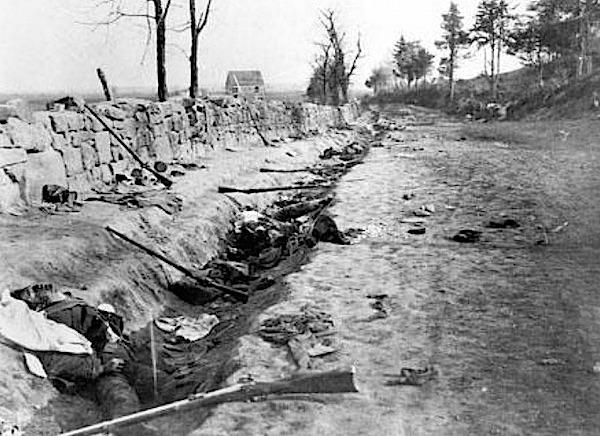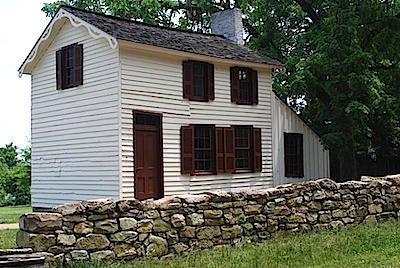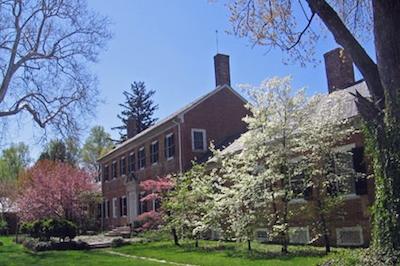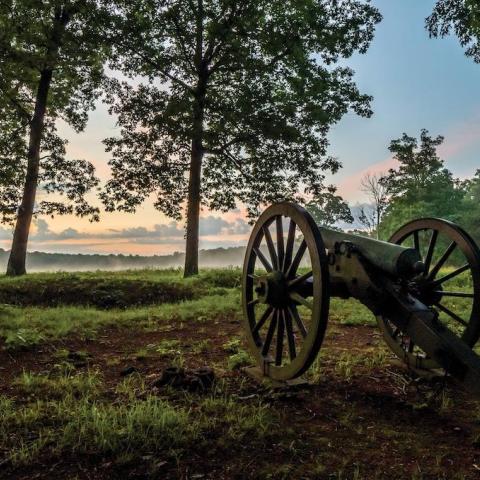
This famous photography was taken probably within an hour after the fighting on May 3, 1863 along the Sunken Road at Fredericksburg. The dead soldiers are members of Barksdale's Brigade/NPS
Take a walk to the Bloody Angle at Fredericksburg and Spotsylvania National Military Park, stand before the Kirkland Memorial just below the Sunken Road, or gaze at the bed where General Thomas 'Stonewall' Jackson died and the gravity of this nation's greatest internal conflict washes over you.
It's not uplifting; in fact, it's somber. Walking the hallowed grounds in the park in northern Virginia you can't help but pause, reflect, and gain some insight into the power of national unity. Whether Union or Confederate, it will set you back on your heels.
It's not nearly as large as the massive size of Great Smoky Mountains National Park or Shenandoah National Park, but its 7,500 acres is packed with interest. There are the four battlefields here: Wilderness, Fredericksburg, Chancellorsville, and Spotsylvania. Plan at least two, and better yet, three, days to walk where they walked.
Here's one possible itinerary:
Day One
Orient yourself by visiting the Fredericksburg and Spotsylvania Battlefield Visitor Center and Bookstore at 1013 Lafayette Boulevard in Fredericksburg, Virginia. Inside the bookstore you'll find shelves well-stocked with guides and books specific to each of the battles that played out here as well as the Civil War in general. There's an informative 22-minute video, and a knowledgeable staff ready to field your questions.
From the visitor center, walk along the Sunken Road. It's bordered by a stone wall; the same one that provided such great protection for the Confederate forces. The gravel pathway leads to views across the battlefield that turned bloody not once, but twice: on December 1862 and again the following May of 1863.
Bullet-splintered boards at the Innis House still bear witness to the mayhem that a speeding lead ball can cause to human flesh. Above on the hill is the colonial mansion of Marye's Heights. More than 8,000 Union troops tried to take the heights...and failed. It was the most one-sided victory by Confederate Gen. Robert E. Lee during the entire war.
Along the Sunken Road also look for the small monument to General Thomas R.R. Cobb, who was mortally wounded during the battle. As the primary writer of the Confederate Constitution, Cobb was the best-known soldier killed in the Battle of Fredericksburg, according to the Park Service.

The Innis House contains scores of bullet holes/Kurt Repanshek.
From the Innis House, head towards the Kirkland Monument. It pays tribute to a young, compassionate Confederate soldier. At battle's end, with permission from his commanding officer, he carried water to the wounded Union troops in the fields below. Down in Fredericksburg itself, gaze across the rocky Rappahannock River: it was here that the Union troops built their pontoon bridges on their way to their destiny.
If time allows, head up to the Fredricksburg National Cemetery where more than 15,000 Civil War dead are buried. It's located adjacent to the visitor center.
Day Two
The Spotsylvania Courthouse Battlefield saw the longest, sustained, intense fight of the Civil War. It may be a pastoral scene now, but it wasn't then.
A trail of less than a mile crosses landscape features with names such as Mule Shoe Salient, and the Bloody Angle. Both of these names were taken from a small "u," or "v"-shaped, ridge, or salient. Defended by the Rebel forces against the Union blue, nothing but carnage followed.
The Confederate forces built log-lined earthworks, at shoulder height, for protection, but as the battle slogged on they just could not hold out against the sheer hell of the Union onslaught. Historians wrote that after the battle, in light rain and mud, the dead were stacked five feet deep.

These days a bridge crosses the "Bloody Angle" on the Spotsylvania Battlefield/NPS
"May God in his mercy never again permit us to behold such a field of carnage and death," one soldier wrote afterward.
Then head to the Chancellorsville Battlefield Visitor Center, near the intersection of the Orange Plank and Furnace roads. Inside you'll find uniforms, weapons, and soldiers' personal belongings from those dismal days.
Just outside, and behind, the building, walk the short trail to the site where Stonewall Jackson was mortally wounded by his own troops - a case of mistaken identity. Along the trail you'll find two monuments to Jackson. One is a small block of quartz where he was initially tended after his wounding, and the other is a larger granite monument, inscribed with the general's name.
From there proceed to the Stonewall Jackson Shrine at 12019 Stonewall Jackson Road in Woodford, Virginia, roughly 17 miles from the center of Fredericksburg. The home at the time was owned by Thomas Coleman Chandler as part of the Fairview Plantation. While doctors initially thought the general would recover from his wounds after amputation of his left arm, he subsequently developed pneumonia, which led to his death.
The plantation's main house no longer stands, but the "farm office," where Jackson spent his dying days, does. Inside the bedroom you'll see where one of the South's mightiest generals passed away.
Day Three
With one day left, don't miss two of the key elements of Fredericksburg and Spotsylvania: Chatham and Elwood. You can visit briefly in half-a-day, or linger to soak up the history.
Chatham is a Georgian-style brick manor that stands high above the Rappahannock River. It dates to the late 1700s when the slave trade flourished here. Though most visitors to the military park are drawn to the four battlefields, Chatham Manor shouldn't be overlooked. It's richly steeped with American history.
During the Civil War the manor was owned by James Horace Lacy, a Southern sympathizer who joined the Confederate Army. His wife and children remained at Chatham until 1862, when the gathering war prompted them to flee and the house became a Union headquarters. It was then pressed into service as a field hospital, and the grounds filled with graves.
All of the graves have been removed and relocated to the National Cemetery, except for three that still remain on the property and can be located with the help of the park rangers and volunteers.

Springtime brings blooms to the grounds of Chatham/NPS
There are a few signs of Chatham's early days. The plantation covered nearly 1,300 acres, and included orchards, a dairy, ice house, and a fishery along the river. But it's all gone now. But the slope of the rear yard down to the river has been restored to how it appeared during the war.
Then take a walk around the 85-acre estate that surrounds the manor, and enter the home. The public areas are devoid of the furnishings of the past. Instead, there are exhibits from the families who lived here, for 250 years and during the military occupation during the Civil War.
Elwood Manor is an important stop if for no other reason than to see where Stonewall Jackson's amputated arm purportedly is buried. Behind the manor, which stands in the Wilderness Battlefield, is a low, stone monument inscribed, simply, 'Arm of Stonewall Jackson, May 3, 1863.'

Is this the final resting ground for Stonewall Jackson's amputated arm?/Kurt Repanshek
While there are stories about the limb being disturbed and reburied, park historian John Hennessy does not doubt that it remains in the family cemetery. And yet, the fate of the arm remains a quirky conversation-starter.
'I think that of all the sites that we manage in our park (and of course there are hundreds and hundreds of them and four major battlefields) Jackson's arm is probably the most curious of them all," the historian told me a few years back. "Visitors wrinkle their noses and their eyebrows when they hear about it, but they still want to see the place. Before Elwood was open to the public, virtually every time I went back there a visitor had managed to find his way, or her way, back there to see. They wanted to see the arm."
'The idea that the arm isn't there, is a pretty recent phenomenon. It is one of those Internet phenomena, at least where I encountered it. There's no reason to believe that it's not there. But it has had an interesting history and a lot of legend and stories surrounding it over the years,' he added.
While three days will give you a good glimpse back in the time when men hunted men during the Civil War, you may want to return and explore other poignant sites within the park, and reflect on a time gone by.


 Support Essential Coverage of Essential Places
Support Essential Coverage of Essential Places







Comments
Many years ago I walked up the long, long hill rising toward Marye's Heights with an NPS interpreter leading our "charge" up the hill. As we walked, he wove a story about the carnage there as Union troops tried over and over to take the hill -- while the commanding officer watched from a church steeple and proudly proclaimed, "How valiant are my men! See how courageously they die!"
The climb up the hill was long and tiring. It wasn't hard to begin imagining how it must have been with slugs of lead and cannonballs tearing past and dropping men all around you.
When we finally reached the wall along the Sunken Road, we sat in quiet shade as the ranger told us of Cpl Richard Kirkland taking water to wounded enemy soldiers who shivered with cold and cried out in pain and dying anguish.
That interpreter's quiet voice, which had a distinct Southern accent, seemed out of place in a spot where not too many years ago chaos and death had reigned. I remember that I had quite a bit of trouble seeing the others in the group because my eyes were filled with water. As I looked at them, I could see that theirs were, too.
Remembering that experience now, I realize that this was a prime example of the incredible value of good, live and personal interpretation of stories like the one there. No electronic presentation or sign board can ever replace a truly good ranger who knows his or her stuff.
Rachel Carson, in her wonderful book A Sense of Wonder, pointed out that before we can teach anyone something, we must touch their emotions. Only when someone has felt dry facts with their heart, be it sadness, grief, anger, joy, curiosity or whatever else may touch us --- only then will the person truly understand and that is the basis of all real learning.
Thanks for sharing this place with us, Kurt.
I've not had the opportunity to visit, but my wife did. She brought me back a tshirt of the Kirkland monument, which - as a former Army medic - had special significence to me.
Some years ago, a person walked into my office at FRSP and said he had a complaint. It seems a relative of his had died at the Bloody Angle. He had researched the route of his relative's company as they moved closer to the battle. He even knew the time at which they had become engaged in the battle. He waited until the correct time and then retraced the footsteps of his relative to the place where he had died. As he came to the spot, he explained that two young men were playing frisbee there. The moment was ruined for him.
Rick